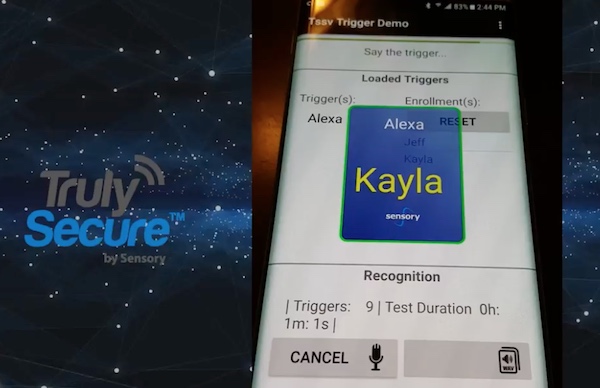Sensory Announces Updated Voice Security with TrulySecure Speaker Verification 2.0
- Sensory announced an updated solution for voice-activated devices and mobile apps that enhances security using voice biometrics
- Rising concerns about voice assistant vulnerability to attacks can be mitigated by applying voice biometric solutions that verify speaker identity before providing access
- The TrulySecure Speaker Verification 2.0 works on-device with minimal power and CPU overhead and does not travel off-device to a cloud service
Sensory, a company known for on-device low-power wake word, voice command and biometric security solutions, recently announced an update to its TrulySecure Speaker Verification (TSSV). TSSV 2.0 is an update to a solution already available from leading smartphone manufacturers such as Samsung, LG, and Motorola. The TSSV security solution uses voice biometrics to restrict device or mobile app access and differentiates based on low power consumption, passphrase flexibility and ease of use.
There is rising interest in adding security to voice-driven technology ranging from smart speakers and smartphones to the apps themselves on mobile devices. Sensory has a unique position in the market because it has focused for many years on voice recognition wake words that activate sessions and work on devices with limited power and CPU capacity. The speaker verification occurs entirely on-device, including the enrollment step which can be used for a single person or multiple people as demonstrated in the video below.
TSSV 2.0 has several configuration options. The solution can secure a device or an app from access. It can be configured to verify multiple voices speaking a common phrase or enable a custom phrase tied to a specific speaker. And, there is a feature called Voice Liveness that, “prevents spoof attacks by presenting an interactive challenge sequence that must be performed to verify that the input is from an actual user and not a recording.”
Device, voice assistant and app developers can access the TSSV 2.0 SDK for a cost of $2,500. The solution supports Android, iOS, Linux, MacOS, Tizen and Windows. There are additional licensing requirements if the solution is put into production.
Security That Restricts Voice Access to Verified Speakers
Voice assistants are most useful when they are permissive in recognizing our voices. We just speak and they respond. Introducing additional steps such as touching a smartphone or entering a PIN slows the process and undermines some of the convenience that voice interaction delivers. However, some recent laboratory tests have demonstrated that ultrasonic and embedded attack voice signals can sometimes activate voice assistants without the user noticing. The DolphinAttack and wav-to-API attack are two recent examples. Even if the voice assistant platforms figure out a way to stop these activation exploits, others are likely to emerge. We also have the example of people activating smart speakers while standing outside of homes.
A simple way to address these security concerns is to restrict devices or certain applications from activating unless the speaker can be verified. This is where solutions like TrulySecure Speaker Verification can meet an emerging market need.









